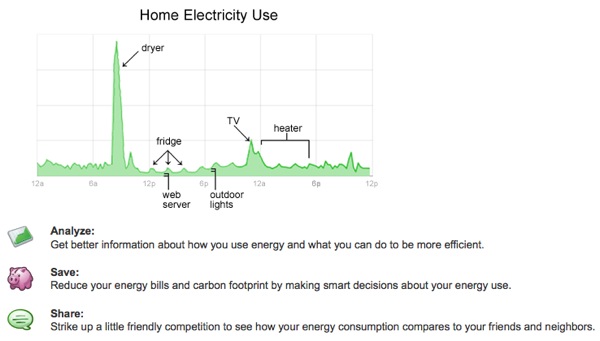
Photo credit Urban Jacksonville
The output from smart meters is incredibly granular. Far more so than is obvious from the smart meter output graph above.
In conversations with Dr Monica Sturm (Director of Siemen’s Center of Competence, Metering Services) last November (2008) she confirmed to me that it is possible to identify individual devices in someone’s home down to make, model and year of manufacture by looking at their energy profile – the output of their smart meter.
This kind of information is absolute gold and don’t think the utility companies aren’t starting to wake up to the fact. They are, and they are not alone. Why else do you think Google have jumped into this space with their PowerMeter offering. Not to be outdone, Microsoft have also stepped in with their Hohm product.
It won’t be long before Apple joins the fray with a sleekier, sexier iHome application!
For the utilities themselves, there are data protection issues to be worked through but once they are (and they will be), the utilities will use this data to help make up for the earnings lost as customers become more energy efficient (consuming less expensive energy).
One revenue model you will start to see emerge is utility companies selling appliances (and possibly even cars!). How will it work?
Because the utility company will have full visibility of our energy consumption, they will see when your devices are inefficient/faulty. I can very easily envisage receiving a communication from my utility company in the not-too-distant future along the lines of:
Dear Mr Raftery (actually, as I am based in Spain it would be more likely to be Estimado Sr. Raftery but let’s stick with the English version),
We notice from your energy profile that you own a 2004 Indesit BAN12NFS fridge freezer. Our records show that in the last 3 months the compressor in that freezer has become much less efficient and it is now costing you €25 a month just to run that one appliance.
We have partnerships with service companies who could try to repair the compressor in that fridge freezer for you, or alternatively, we have a special offer this month on new energy efficient fridge freezers.
We can have a brand new fridge freezer installed in your home before the end of the week. We can take away your old one for responsible disposition. And all this will won’t cost you a penny, in fact it will save you €10* per month off your current bill!
So, to summerize, if you call our hotline now on 555-123 4567 you can save €10 off your monthly bill, have a brand new fridge-freezer installed free and reduce your CO2 emissions by 12kg a year.
What are you waiting for?
*We charge you €15 per month for the new fridge thus saving you €10 per month off your current bill. Terms and conditions apply.
That’s just one possible scenario of how the utility companies will make use of smart meter data to generate alternative revenue streams for themselves – can you think of others?

As far as I’m aware, having kWh usage information for every few seconds is not enough to profile appliances in the home. Reactive power measurements are also required. I dont think there are any home energy meters you can buy that measure reactive power – not sure if the smart meters being rolled out gather this data.
Do you know any more about the technicalities behind this? Are there meters out there that already capture this information?
It will be interesting to see who becomes responsible for the database that stores all these product power profiles… i think i read that there was some initiative started a few years back.
Jon,
Tbh I didn’t go into the technicalities of this with Monika. I just took her at her word that the data from smart meters is granular enough to identify appliances.
Re the database – I have seen estimates that smart meters will generate up to 400mb of data each (depending on how often they are sampling) per annum. When you multiply this up by a few million customers and factor in data retention legislation you are looking at terabytes of data storage, possibly even petabytes.
Tom – Very well written. I thought I’d take a moment and go into a bit more detail than the 140-character retweet I sent earlier.
I hadn’t thought of how each appliance can have a unique power signature, but it makes sense. What comes to mind are how voice recognition systems identify patterns in speech waveforms rather than looking at all the unique ways people can pronounce a word or phrase. As you describe, these unique signatures can trigger incredibly precise, focused communications through customer bills, web portals and a host of mobile devices.
Keeping in mind I harbor some concerns over privacy issues (including the possibility of bringing the concept of spam to a completely new level), this capability has the potential to radically transform behaviors in a positive way – both for customers and for energy suppliers.
Mike Balin
http://www.streamserve.com
twitter.com/mikebalin
how about a follow up where we do go into some depth with Monika. its an extremely interesting topic.
Sounds like something government carbon taxes would also do well to mine. Incentivise people to upgrade to more efficient devices with lower taxes.
You can keep it simple with a carbon tax on your overall electricity usage but it will be more effective if the tax structure highlighted to people exactly how they could cut their electricity usage. Action steps, not just broad penalties.
Personally though I want to own and control this data. Not out of fear but because I want to be able to explicitly share my data with Electrolux and have them offer me a discount.